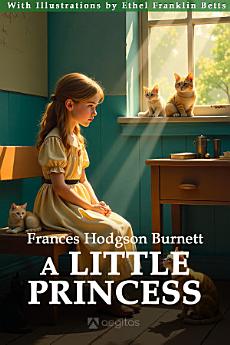A Little Princess. Being The Whole Story Of Sara Crewe Now Told For The First Time.: with Illustrations In Colors By Ethel Franklin Betts
About this ebook
Despite her the adversities, Sara remains a beacon of kindness and grace, her imagination a vivid escape from her grim reality. Through storytelling, she captivates those around her, fostering friendships that transcend social boundaries. Her interactions with the school's feral cats and loyal kitchen maid Becky highlight themes of loyalty and compassion.
Central to the narrative are symbols like the shaft of sunlight in Sara's attic room, representing hope and the persistence of the human spirit, and the cobweb strands within hit signify the strength found in unity and perseverance.
The story culminates in a heartwarming revelation when a mysterious benefactor, later revealed to be her father, returns, restoring Sara's lost fortune and reaffirming Burnett's message of hope's triumph over adversity. This twist not only underscores the novel's thematic core but also cements A Little Princess as a timeless testament to the transformative power of imagination and the unyielding strength of kindness in the face of life's inevitable trials.
Burnett's narrative, while rooted in its Victorian context, speaks to universal truths about the essence of true nobility lying not in one's birthright or material wealth but in the richness of one's character. Through Sara Crewe's journey, readers are reminded of the undying magic of childhood dreams and the profound impact of maintaining a kind heart amidst the world's challenges.
About the author
Frances Hodgson Burnett was a British-American novelist and playwright, renowned for her contributions to children's literature in the late 19th and early 20th centuries. Born in 1849 in Cheetham, England, Burnett moved to the United States with her family during her childhood. This transatlantic journey profoundly influenced her writing, infusing her stories with a blend of English and American sensibilities.
Burnett's literary career spanned several genres, but she is best remembered for her enchanting tales for children. Her notable works include Little Lord Fauntleroy, A Little Princess, and The Secret Garden. These stories, rich with themes of social critique, personal growth, and the redemptive power of nature and imagination, have captivated readers for generations.
A Little Princess, published in 1905, tells the story of Sara Crewe, a resilient and imaginative girl who perseveres through hardship and adversity, emphasizing themes of kindness, hope, and the importance of inner beauty over material wealth. Similarly, The Secret Garden (1911) explores the rejuvenating properties of nature and friendship through the transformation of its main characters and their garden.
Burnett's writing style is characterized by its warmth, detailed character development, and moral depth, reflecting her own life's complexities and shifts between societal classes. Although not always immediately appreciated during her lifetime, her stories have endured, translated into numerous languages, and adapted into films, plays, and television series. Frances Hodgson Burnett passed away in 1924, but her legacy continues to inspire and entertain children and adults alike, cementing her as a pivotal figure in children's literature. Her work remains a testament to the transformative power of storytelling and the enduring appeal of exploring complex themes through simple narratives.




